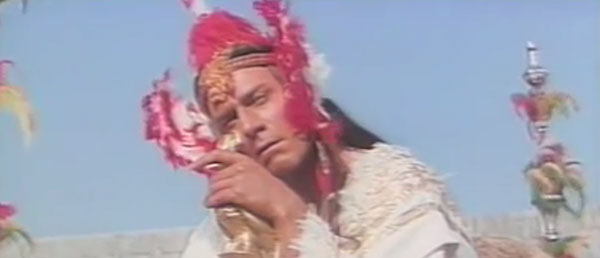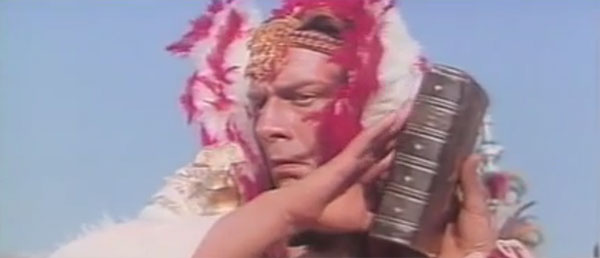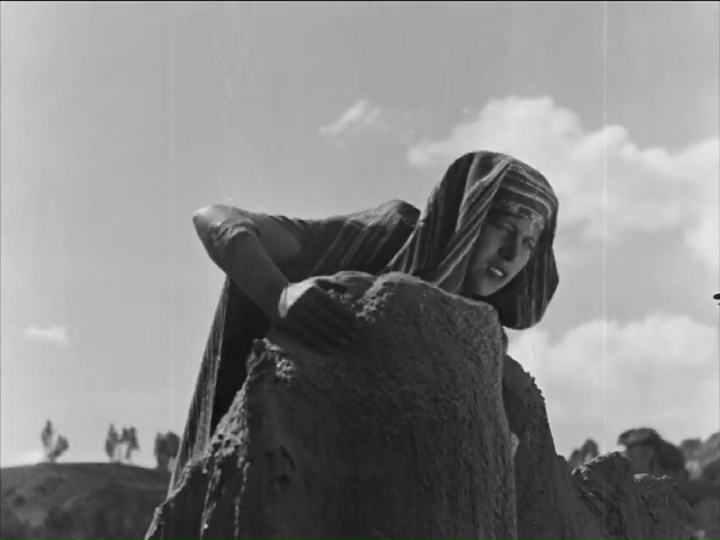Bolivia’s only known surviving silent era film is set when the Inca were a force in South America but a prophet warns that violent change is coming. Sure enough, the Spanish conquistadors arrive in search of gold and things get bloody, to put it mildly. And so, it’s rather awkward when an Aymara princess falls for a Spanish capitan.
The Princess Diaries
José María Velasco Maidana can never be accused of thinking small. With the Bolivian film industry in its infancy and only one other cinematic project under his belt, he set out to create a super-production, an epic historical romance to rival the output of Hollywood.
The production of Wara Wara took longer than expected and the hoped-for international distribution did not work out as planned. The film was thought lost for decades before being recovered in a state that can safely be described as less than pristine.

I’ll discuss the recovery and restoration of Wara Wara further in the review but I should mention that unlike the case of The Hussar of Death and its director Pedro Sienna, Wara Wara’s Velasco Maidana did not live long enough to assist in the restoration of the film. The reconstruction that we are about to discuss is a labor of love made even more challenging by the inability to consult the film’s main creative force. Snippets of footage are still considered lost and 99% of the title cards are the best guess of the restoration team. As a result, I will not be holding any resulting choppiness or rushed sequences against the picture.
While it deals with the Spanish conquest of the Inca Empire, Wara Wara was designed with international distribution in mind and so it does a good job of explaining the whos, whats and hows of its historical period and the cultures of its cast. Don’t worry, if you can deal with the factions of Middle Earth or the Alpha Quadrant, this will be a piece of cake.

The film opens in the palace of Calicuma (Ventura Pampa V.), ruler of Collasuyo (often spelled Qullasuyu in English sources), one of the four regions of the Inca empire. Calicuma’s only daughter is Wara Wara (Juanita Tallansier G.), who is obviously our heroine seeing as how her name is the title of the film. (Wara Wara’s nationality is described as Aymara, which was a vassal state of the Inca, but she is also the niece of Atahualpa, the ruler of the Incas.)
There’s a party going on with all the trimming but then a poet named Arawicu (Dámaso E. Delgado) approaches the royal family with a dark prophesy. He says that their gods are angry at the rivalry between Atahualpa and his brother, Huascar. (History Corner: They were two sons of the king and civil war broke out, brother against brother. Atahualpa was winning at this point.)

Arawicu declares that their gods will use a terrible race from the sea to punish the Inca for this unseemly rivalry. Calicuma is not amused and has Arawicu thrown in prison but Wara Wara believes him and delivers food to his cell.
Meanwhile, everything Arawicu has spoken of is coming to pass. The Spaniards arrive and capture Atahualpa. Although a ransom of a roomful of gold is delivered, the conquistadors strangle him anyway. Calicuma, enraged by the murder, gathers his army to fight the invaders but falls in battle. Wara Wara’s mother is killed when the Spaniards invade the palace and she flees with the priest Huillac Huma (Arturo Borda).

Five years pass. Wara Wara has become the symbol of the resistance movement but the conquistadors continue to make gains and are steadily taking control of the kingdom. Captain Tristan de la Vega Florida (Jose Velasco) is exploring along with his valet, Barbolin Gordillo (Emmo Reyes F.). Tristan spots Wara Wara being harassed by soldiers under his command and defends her but is wounded and taken back to the hideout of the resistance.
Huillac Huma wants to kill the young captain but Wara Wara refuses to allow it. I know you will find this hard to believe, but she is falling for Tristan. As you can well imagine this goes over not at all with the members of the resistance and there is danger on all sides. Will our star-crossed couple survive with their love intact? Watch Wara Wara to find out!

José María Velasco Maidana did not enjoy the support of a full Hollywood studio (or German or French or any of the major filmmaking nations of the time) and that meant that he had to perform many of the tasks that would have been jobbed out to assistants. His home was filled with women sewing costumes for the picture and he played the violin to entertain the crew as they worked.
Filming was halted halfway through production and when it was restarted, Tristan and Wara Wara were recast. I had heard that the original female lead, author and feminist Ana Rosa Tornero, walked because she objected to the kiss at the finale of the picture. I found this confusing as, even allowing for a more conservative culture, the embrace at the end of Wara Wara is quite prim. The mystery was solved by filmmaker Fernando Vargas Villazón, who oversaw the restoration and published frames of the original kisses between Tornero and her leading man, Luis Pizarroso Cuenca. They are along Hollywood lines, not exactly red hot stuff but one can easily understand Tornero’s discomfort.

With the new cast, Wara Wara was finally released in 1930. The Bolivian press was favorable and encouraged seeing the film as an act of patriotism. It should be noted, though, that some members of the audience found the exaggerated acting to be humorous and at least one critic found the picture timid in its approach. Still, the film was a popular success even if dreams of international acclaim took seven decades or so to come about.
As is the case with most reconstructed films, Wara Wara is not 100% complete. Quite a few intertitles are missing from the picture. (Almost all of them had to be reconstructed based on the notes, synopsis and the best guesses of the restorers.) It is still easy to follow the action on the screen but it’s important to know that the picture is not exactly what was shown in 1930. This is no crack at the restoration team, they did a splendid job and deserve much praise, but rather a warning to viewers that the original film would have been slightly different.

As silents go, this picture is pretty title-heavy. The extra explanatory title cards were necessary as Wara Wara was intended for international distribution but the delay in filming proved to be fatal for that hope. The picture was a hit in Bolivia but selling an all-silent film was a shaky proposition in 1928 and impossible in 1930.
Limited distribution meant a limited number of prints and Wara Wara was considered a lost film for decades before being rediscovered in a trunk in 1989. What was found was not the edited film but the camera negative, which meant that the restoration team would have to recut the picture from scratch from a mountain of raw footage. A similar situation occurred with the 1922 version of Sherlock Holmes but in that case, the original director was still alive and able to assist with the work. José María Velasco Maidana died the same year Wara Wara was rediscovered (the footage was in the basement of his house) and so the process had to go on without him.

Using as many primary sources as possible, the story of the film was painstakingly reconstructed. The process took twenty years but the result is stunning, as you can probably tell from the screencaps in this review.
As is often the case with films set in the distant past, the performers in Wara Wara do adopt a more formal acting style, heavy on poses. This isn’t surprising but it does mean that the film requires a more sympathetic audience at times, one that understands the different flavors and tones of silent film acting.

Wara Wara certainly has a lower budget compared to other super-productions but it makes good use of its advantages. Velasco Maidana makes excellent use of the countryside, showcasing the towering cliffs, deep crags and caves. The biggest risk for a lower-budget epic is that lack of funds will render it dinky. While Wara Wara does scrimp on its extras (especially noticeable during battle scenes for obvious reasons), Velasco Maidana keeps things full-size by constantly dwarfing his cast against the epic landscape. John Ford had Monument Valley but Velasco Maidana had Lake Titicaca and that’s nothing to sneeze at.

Over the years, Hollywood has generally been more interested in portraying Native Americans from north of the Mexican border, though there have always been notable exceptions. William S. Hart, cowboy extraordinaire, donned a loincloth and took on Aztecs in 1916’s The Captive God, while Geraldine Ferrar played an Aztec princess (complete with feathered headdress and metal brassiere) in The Woman God Forgot (1917).
In the talkie era, Tyrone Power had his own Aztec conquest in Captain from Castile (1947), George Chakiris and Yul Brynner were cast as rival monarchs (Chakiris plays a Mayan with a greaser bouffant) in the truly bizarre Kings of the Sun (1963) and Christopher Plummer took on the role of Atahualpa in The Royal Hunt of the Sun (1969). There are other films, some quite famous, but I want to bring Wara Wara back into the conversation.

In many of the Hollywood films set during the Spanish conquest of the New World, the historical aspect gets lost under the spectacle and romance. These are stories that could have been set anywhere and are not particularly interested in portraying the points of view of their indigenous characters. Even films like Kings of the Sun in which all the characters are Native Americans of various nations, the story could have been set in Mesopotamia or Mesoamerica for all the screenwriters knew or cared.
Wara Wara, on the other hand, takes care to showcase the distinctiveness of the Inca and Aymara. Sure, the story is a fairly generic riff on the Pocahontas myth but the early world building of the first act serves the film well and gives the performers a solid foundation upon which to work. In short, this is not one of those “look at the weird people who don’t do things our way” films.

Velasco Maidana calls for a blending of European and indigenous cultures with his Romeo and Juliet narrative. I’m not sure if the ending supports this sentiment. (Spoiler: The film ends with the Spanish massacring the Incan resistance and then Tristan and Wara Wara embracing by the lake. This seems cold but a good portion of the film’s lost footage is from the end, so there may have been scenes that clarified Wara Wara’s reaction to the deaths of her people.) My point is that I don’t have enough information to correctly process the ending.
Wara Wara is quite rightly viewed as one of the building blocks of Bolivian cinema and the story of its survival is every bit as remarkable as the action on the screen.
Where can I see it?
Wara Wara is available for digital rental or purchase. The film is accompanied by a score that includes music composed by the film’s director as well as traditional music. It runs at 24 fps, which I personally think renders the action jerky and unnatural but there is no way I am starting a frame rate discussion today. There are no English subtitles, so you will want to use a translation app or ask friends for help if you do not speak Spanish. (Be sure to repay an interpretation assistance with plenty of delicious snacks.)

While Wara Wara only briefly touches on Francisco Pizarro’s execution of Atahualpa, god-king of the Incas, The Royal Hunt of the Sun makes this confrontation between old world and new the center of its narrative.
Based on the play of the same name by Peter Shaffer, it follows Pizarro (Robert Shaw) as he travels from Spain to Peru in search of gold. His wildest dreams are realized when he captures Atahualpa (Christopher Plummer), who promises to fill one room with gold and two with silver in exchange for his freedom. Always an outsider among the rich and aristocratic (he is neither), Pizarro finds himself drawn to the confidence and naïveté of Atahualpa, who sees himself as the literal son of the sun.

The word most often used to describe this film is “eccentric” and I agree that it is indeed an oddball at times. Off-kilter music cues, random squeaks and chirps from Plummer and an absolute determination to absolve Pizarro of guilt in the eventual murder of the captive god all combine to create a quivering mountain of weird.
While the film does take care to show the hypocrisy of forced conversion (the ostensible reason for the expedition) and the perfidy of many of the Europeans under Pizarro’s command, it is still told very much through a European lens. The film is about how Atahualpa effects Pizarro but we learn almost nothing about the monarch of the Incas beyond the fact that deification is a helluva drug.

The Royal Hunt of the Sun, no doubt owing to director Irving Lerner’s experience with documentaries, does an excellent job of establishing its atmosphere and contrasting the cultures of the Spaniards and the Incas. It’s a shame that the internal world of Atahualpa remains fairly off-limits to the audience.
Unlike Wara Wara, which withholds the major Spanish character until the halfway point, The Royal Hunt of the Sun gives us Spain galore but does not fully unveil its main Incan character until the second act. This simple ratio flip makes all the difference. In Wara Wara, we feel the fear and hurt of the Inca because we experienced the Spanish attacks alongside them.

The Royal Hunt of the Sun is not a bad film and several scenes are quite moving (the final scene in particular) but it is at time just as naively arrogant as its characterization of Atahualpa. It assumes that we will be fascinated by Pizarro’s religious doubts but, frankly, it’s going to take a lot to make me give a fig about a conquistador. I really don’t care whether or not he had a rotten childhood because all the Incas that he killed are just as dead.
(I should also note that, unlike Wara Wara, The Royal Hunt of the Sun rushes through explaining the power struggles within the Inca Empire and frames it in relation to Pizarro’s status as a bastard. Oversimplification of a complex culture, no matter how good the intention, is never desirable and those double for a conquistador making it all about meeeeeee.)

In the end, The Royal Hunt of the Sun is worth seeing if you want to see the events of Wara Wara as they were popularly portrayed to mid-century audiences. And if you want to see Christopher Plummer in a loincloth.
Availability: Released on DVD.
***
Like what you’re reading? Please consider sponsoring me on Patreon. All patrons will get early previews of upcoming features, exclusive polls and other goodies.

Wara Wara is just the sort of obscure international silent that I treasure – thanks for the review, I’ll be sure to check it out.
Glad to help point more viewers in its direction. I hope you enjoy. 🙂
The Wara Wara screen grabs are just beautiful! Really want to see this one!
The restoration is so lovely! Crystal clear with very little damage showing. It took 20 years but so worth it!
British film critic Leslie Halliwell complains that “Royal Hunt of the Sun” is a “deadly literal” film version of Peter Shaffer’s play which displayed “theatrical splendour” on stage. It might be worth noting that dramatist Shaffer also wrote “Amadeus,” another play that indulged in historical distortion by vilifying composer Salieri.
I also think that it was a mistake to relegate Martin to the background. More than almost any other story, this bit of history would require an outside (and, in the case of Martin, innocent) viewpoint.